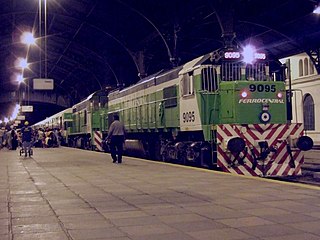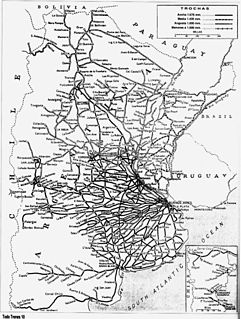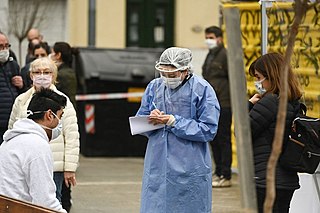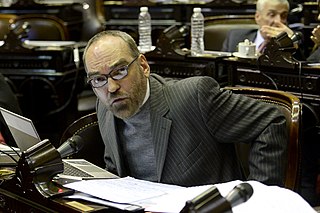
Ferrocentral was an Argentine private railway company, with a name formed by a combination of the Spanish words for "Central Rail". It operated long-distance passenger trains from its base at Retiro station in Buenos Aires to several locations in northern Argentina, running on Ferrocarril Mitre's 5 ft 6 in Indian gauge tracks.

Rodrigo Alejandro Bueno, also known by his stage name Rodrigo or his nickname "El Potro", was an Argentine singer of cuarteto music. He is widely regarded as the best, most famous and most influential singer in the history of this genre. Bueno's style was marked by his on-stage energy and charisma. His short, dyed hair and casual clothes differed from typical cuarteto singers with strident colors and long curly hair. During his career, Bueno expanded cuarteto music to the Argentine national scene, remaining one of the main figures of the genre.

Television is one of the major mass media of Argentina. As of 2019, household ownership of television sets in the country is 99%, with the majority of households usually having two sets. Cable television has become the most used type of delivering, with 73.2% of households having a cable provider.

The Argentine railway network consisted of a 47,000 km (29,204 mi) network at the end of the Second World War and was, in its time, one of the most extensive and prosperous in the world. However, with the increase in highway construction, there followed a sharp decline in railway profitability, leading to the break-up in 1993 of Ferrocarriles Argentinos (FA), the state railroad corporation. During the period following privatisation, private and provincial railway companies were created and resurrected some of the major passenger routes that FA once operated.

The 17A protests were a series of massive demonstrations in Argentina which took place on August 17, 2020, amid the COVID-19 pandemic, for several causes, among which: the defense of institutions and separation of powers, against a justice reform announced by the government, against the way quarantine was handled, the lack of liberty, the increase in theft, and a raise on state pensions.

The 18A was an Argentine cacerolazo that took place on April 18, 2013. Attended by nearly two million people, it was the largest demonstration at the time against the president Cristina Fernández de Kirchner.

8N was the name given to a massive anti-Kirchnerism protest in several cities in Argentina, including Buenos Aires, Córdoba, Rosario, Mendoza, Olivos, among many others throughout Greater Buenos Aires and other regions; on 8 November 2012. There were also protests in Argentine embassies and consulates in cities such as New York, Miami, Madrid, Sydney, Bogotá, Santiago de Chile, Naples, Zurich and Barcelona, among others. The protest was considered not only a call to Kirchnerism, but also to the opposition, because they did not have a strong leader.

The 2012 Buenos Aires rail disaster, also known as the Once Tragedy, occurred on 22 February 2012, when a train crashed at Once Station in the Balvanera neighbourhood of Buenos Aires, Argentina.

Operadora Ferroviaria Sociedad del Estado is an Argentine state-owned company created in 2008 to operate passenger services in Argentina. It is a subsidiary of the Ferrocarriles Argentinos holding company.

The A Bailar Tour was the first headlining concert tour by Argentine recording artist Lali in support of her debut studio album, A Bailar (2014). The tour began on April 19, 2014, in Buenos Aires and concluded in on April 25, 2016, Tel Aviv. It was the highest-grossing tour of 2015 in Argentina.

Corredores Ferroviarios was an Argentine private company that operated the Mitre and San Martín railway services in Buenos Aires Province for about one year until the Government of Argentina rescinded the agreement with the company in March 2015. Since then, the Mitre and San Martín line are operated by State-owned company Operadora Ferroviaria Sociedad del Estado (SOFSE).

Tucumán is a train station in the city of San Miguel de Tucumán of Tucumán Province, Argentina, and terminus of Ferrocarril Mitre.

Horacio Rodríguez Larreta is an Argentine economist, politician and the current Chief of Government of the City of Buenos Aires.

Citizen's Unity was a centre-left Kirchnerist political coalition in Argentina for the 2017 legislative elections led by the former President Cristina Fernández de Kirchner.

The COVID-19 pandemic in Argentina is part of the worldwide pandemic of coronavirus disease 2019 caused by severe acute respiratory syndrome coronavirus 2. On 3 March 2020, the virus was confirmed to have spread to Argentina. As of 7 March 2022, a total of 8,934,328 people were confirmed to have been infected, and 126,708 people were known to have died because of the virus. On 7 March 2020, the Ministry of Health confirmed the country's first documented death, a 64-year-old man who had travelled to Paris, France, who also had other health conditions; the case was only confirmed as positive after the patient's demise.

Fernando Adolfo Iglesias is an Argentine journalist, writer, politician, and volleyball player. Currently he is a National Deputy elected in Buenos Aires. He is a member of the center right party Republican Proposal.
The following is a timeline of the COVID-19 pandemic in Argentina.
The 2020 COVID-19 pandemic in Argentina had an impact on the human rights situation in the country.

This article presents official statistics gathered during the COVID-19 pandemic in Argentina. The National Ministry of Health publishes official numbers every night.
The Argentine COVID-19 vaccination scandal, known in Argentina as vacunatorio VIP, is a political scandal related to the application of COVID-19 vaccines in the Ministry of Health of Argentina to citizens who, due to the limitations established in the vaccination protocol, were not authorized to receive these vaccines yet.

















